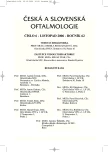-
Medical journals
- Career
Dry Eye Syndrome in Patients with Conjunctival Concretions
Authors: P. Haicl; H. Janková; K. Jirsová 1
Authors‘ workplace: Oční klinika VFN s 1. LF UK, Praha přednosta doc. MUDr. B. Kalvodová, CSc. ; Oční tkáňová banka a laboratoř Oční kliniky VFN vedoucí Mgr. K. Jirsová, PhD. 1
Published in: Čes. a slov. Oftal., 62, 2006, No. 6, p. 415-422
Overview
Purpose:
To establish the possible correlation between the presence of conjunctival concretions and the instability of the tear film.Methods:
The group consisted of 50 asymptomatic patients with accidentally detected conjunctival concretions, presented mostly for refractive errors at the outpatient department of the Department of Ophthalmology, School of Medicine Hospital, Prague, Czech Republic. The age of the patients ranged 24–69 years, mean 44.1 years. In 35 patients (group A) were present the conjunctival concretions only, in the remaining 15 patients (group B), together with the concretions, the Meibomian glands dysfunction was also discovered. The complete eye examination was performed, including detailed analysis of tarsal conjunctiva and fornices, Schirmer’s test I, the tear film break-up time (BUT) and rose bengal staining. In five patients, the mucin ferning test (MFT) was also performed.Results:
Advanced to severe tear deficiency was detected in 42.8 % of patients of the group A, and in 46.6 % of patients in the group B respectively. BUT was shorter or extremely shorter (< 10 sec) in 51.4 % of patients in the group A and in 60 % of patients in the group B. The pathological staining with bengal rose was not detected even in a single patient. MFT was normal in all 5 examined patients (classification I and II).Conclusion:
In patients with conjunctival concretions, the tear film deficiency may be present (decreased values of the Schirmer’s test and BUT). The tear film break-up time (BUT) is surprisingly shorter in younger patients (younger than 45 years of age), in patients with and also without Meibomian glands dysfunction as well. In older patients (over 45 years of age), the defect of the aqueous layer is more pronounced. Patients with conjunctival concretions are potentially affected with the dry eye syndrome.Key words:
conjunctival concretions, dry eye, Schirmer’s test, the tear film break-up time (BUT), bengal rose staining, mucine fehrning test (MFT)
Labels
Ophthalmology
Article was published inCzech and Slovak Ophthalmology

2006 Issue 6-
All articles in this issue
- Epidemiology of the Endocrine Orbitopathy
- The Contrast Sensitivity Test in Early Detection of Ocular Changes in Children, Teenagers, and Young Adults with Diabetes Mellitus Type I.
- Long-term Functional Effect of Pars Plana Virtrectomy in Complications of Prolipherative Diabetic Retinopathy
- Chronic Postoperative Endophthalmitis
- Our Experience with Sub-Tenon’s Anesthesia in Ophtalmic Surgery
- Dry Eye Syndrome in Patients with Conjunctival Concretions
- Czech and Slovak Ophthalmology
- Journal archive
- Current issue
- Online only
- About the journal
Most read in this issue- Chronic Postoperative Endophthalmitis
- Dry Eye Syndrome in Patients with Conjunctival Concretions
- Epidemiology of the Endocrine Orbitopathy
- Long-term Functional Effect of Pars Plana Virtrectomy in Complications of Prolipherative Diabetic Retinopathy
Login#ADS_BOTTOM_SCRIPTS#Forgotten passwordEnter the email address that you registered with. We will send you instructions on how to set a new password.
- Career

